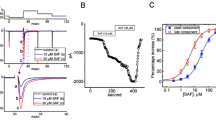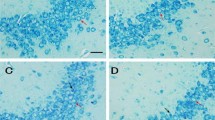Abstract
How sodium metabisulfite (SMB; Na2S2O5), a popular food preservative and antioxidant, interacts with excitable membrane and induces excitotoxicity is incompletely understood. In this study, the patch-clamp technique was used to investigate and record the electrophysiological effect of SMB on electrically excitable HL-1 cardiomyocytes and NSC-34 neurons, as well as its relationship to pilocarpine-induced seizures and neuronal excitotoxicity in rats. We used Western blotting, to analyze sodium channel expression on hippocampi after chronic SMB treatment. It was found that voltage-gated Na+ current (I Na) was stimulated, and current inactivation and deactivation were slowed in SMB-treated (30 μM) HL-1 cardiomyocytes. SMB-induced increases of I Na were attenuated in cells treated with ranolazine (10 μM) or eugenol (30 μM). The current-voltage relationship of I Na shifted to slightly more negative potentials in SMB-treated cells, the peak I Na with an EC50 value of 18 μM increased, and the steady-state inactivation curve of I Na shifted to a more positive potential. However, the tail component of the rapidly activating delayed-rectifier K+ current (I Kr) was dose-dependently inhibited. Cell-attached voltage-clamp recordings in SMB-treated cells showed that the frequency of action currents and prolonged action potential were higher. In SMB-treated NSC-34 neurons, the peak I Na was higher; however, neither the time to peak nor the inactivation time constant (I Na) changed. Pilocarpine-induced seizures were exacerbated, and acute neuronal damage and chronic mossy fiber sprouting increased in SMB-treated rats. Western blotting showed higher expression of the sodium channel in cells after chronic SMB treatment. We conclude that SMB contributes to the sodium channel-activating mechanism through which it alters cellular excitability and excitotoxicity in wide-spectrum excitable cells.












Similar content being viewed by others
References
Cashman NR, Durham HD, Blusztajn JK, Oda K, Tabira T, Shaw IT, Dahrouge S, Antel JP (1992) Neuroblastoma x spinal cord (NSC) hybrid cell lines resemble developing motor neurons. Dev Dyn 194(3):209–221. https://doi.org/10.1002/aja.1001940306
Catterall WA, Kalume F, Oakley JC (2010) NaV1.1 channels and epilepsy. J Physiol 588(11):1849–1859. https://doi.org/10.1113/jphysiol.2010.187484
Chang YC, Huang AM, Kuo YM, Wang ST, Chang YY, Huang CC (2003) Febrile seizures impair memory and cAMP response-element binding protein activation. Ann Neurol 54(6):706–718. https://doi.org/10.1002/ana.10789
Chen BS, Lo YC, Peng H, Hsu TI, Wu SN (2009) Effects of ranolazine, a novel anti-anginal drug, on ion currents and membrane potential in pituitary tumor GH(3) cells and NG108-15 neuronal cells. J Pharmacol Sci 110(3):295–305. https://doi.org/10.1254/jphs.09018FP
Chen S, Du J, Liang Y, Zhang R, Tang C, Jin H (2012) Sulfur dioxide restores calcium homeostasis disturbance in rat with isoproterenol-induced myocardial injury. Histol Histopathol 27(9):1219–1226. 10.14670/HH-27.1219
Claycomb WC, Lanson NA Jr, Stallworth BS, Egeland DB, Delcarpio JB, Bahinski A, Izzo NJ Jr (1998) HL-1 cells: a cardiac muscle cell line that contracts and retains phenotypic characteristics of the adult cardiomyocyte. Proc Natl Acad Sci 95(6):2979–2984. https://doi.org/10.1073/pnas.95.6.2979
Costantin JL, Charles AC (1999) Spontaneous action potentials initiate rhythmic intercellular calcium waves in immortalized hypothalamic (GT-1) neurons. J Neurophysiol 82(1):429–435
Cox JJ, Reimann F, Nicholas AK, Thornton G, Roberts E, Springell K, Karbani G, Jafri H, Mannan J, Raashid Y, Al-Gazali L, Hamamy H, Valente EM, Gorman S, Williams R, McHale DP, Wood JN, Gribble FM, Woods CG (2006) An SCN9A channelopathy causes congenital inability to experience pain. Nature 444(7121):894–898. https://doi.org/10.1038/nature05413
Dib-Hajj SD, Cummins TR, Black JA, Waxman SG (2007) From genes to pain: Nav 1.7 and human pain disorders. Trends Neurosci 30(11):555–563. https://doi.org/10.1016/j.tins.2007.08.004
Dooms-Goossens A, de Alam AG, Degreef H, Kochuyt A (1989) Local anesthetic intolerance due to metabisulfite. Contact Dermatitis 20(2):124–126. https://doi.org/10.1111/j.1600-0536.1989.tb03120.x
Feher JJ, LeBolt WR (1990) Stabilization of rat cardiac sarcoplasmic reticulum Ca2+ uptake activity and isolation of vesicles with improved calcium uptake activity. Mol Cell Biochem 99(1):41–52. https://doi.org/10.1007/BF01261392
Hancox JC, James AF (2008) Refining insights into high-affinity drug binding to the human ether-à-go-go-related gene potassium channel. Mol Pharmacol 73(6):1592–1595. https://doi.org/10.1124/mol.108.047563
Hemendinger RA, Armstrong EJ 3rd, Brooks BR (2011) Methyl vitamin B12 but not methylfolate rescues a motor neuron-like cell line from homocysteine-mediated cell death. Toxicol Appl Pharmacol 251(3):217–225. https://doi.org/10.1016/j.taap.2011.01.003
Hsu YY, Chen CS, Wu SN, Jong YJ, Lo YC (2012) Berberine activates Nef2 nuclear translocation and protects against oxidative damage via a phosphatidylinositol 3-kinase/Akt-dependent mechanism in NSC34 motor neuron-like cells. Eur J Pharm Sci 46(5):415–425. https://doi.org/10.1016/j.ejps.2012.03.004
Huang CW, Cheng JT, Tsai JJ, Wu SN, Huang CC (2009) Diabetes aggravates epileptic seizures and status epilepticus-induced hippocampal damage. Neurotox Res 15(1):71–81. https://doi.org/10.1007/s12640-009-9008-2
Huang CW, Chow JC, Tsai JJ, Wu SN (2012) Characterizing the effects of eugenol on neuronal ionic currents and hyperexcitability. Psychopharmacology 221(4):575–587. https://doi.org/10.1007/s00213-011-2603-y
Huang CW, Lai MC, Cheng JT, Tsai JJ, Huang CC, Wu SN (2013) Pregabalin attenuates excitotoxicity in diabetes. PLoS One 8(6):e65154–e65160. https://doi.org/10.1371/journal.pone.0065154
Jo T, Iida H, Kishida S, Imuta H, Oonuma H, Nagata T, Hara H, Iwasawa K, Soma M, Sato Y, Nagase T, Nagai R, Nakajima T (2005) Acute and chronic effects of eicosapentaenoic acid on voltage-gated sodium channel expressed in cultured human bronchial smooth muscle cells. Biochem Biophys Res Commun 331(4):1452–1459. https://doi.org/10.1016/j.bbrc.2005.04.062
Kayraldizi A, Kayai FF, Canimoğlui S, Rencuzoğullari E (2006) Mutagenicity of five food additives in Ames/Salmonella/microsome test. Ann Microbiol 56(2):129–133. https://doi.org/10.1007/BF03174993
Kencebay C, Derin N, Ozsoy O, Kipmen-Korgun D, Tanriover G, Ozturk N, Basaranlar G, Yargicoglu-Akkiraz P, Sozen B, Agar A (2012) Merit of quinacrine in the decrease of ingested sulfite-induced toxic action in rat brain. Food Chem Toxicol 52C:129–136
Küçükatay V, Genç O, Kocamaz E, Emmungil G, Erken H, Bagci H (2008) Spinal reflexes in normal and sulfite oxidase deficient rats: effect of sulfite exposure. Toxicol Ind Health 24(3):147–153. https://doi.org/10.1177/0748233708092225
Lee IM, Tsai SS, Ho CK, Chiu HF, Yang CY (2007) Air pollution and hospital admissions for congestive heart failure in a tropical city: Kaohsiung, Taiwan. Inhal Toxicol 19(10):899–904. https://doi.org/10.1080/08958370701479406
Liu L, Yang TM, Liedtke W, Simon SA (2006) Chronic IL-1beta signaling potentiates voltage-dependent sodium currents in trigeminal nociceptive neurons. J Neurophysiol 95(3):1478–1490. https://doi.org/10.1152/jn.00509.2005
Lossin C, Wang DW, Rhodes TH, Vanoye CG, George AL Jr (2002) Molecular basis of an inherited epilepsy. Neuron 34(6):877–884. https://doi.org/10.1016/S0896-6273(02)00714-6
Mao W, You T, Ye B, Li X, Dong HH, Hill JA, Li F, Xu H (2012) Reactive oxygen species suppress cardiac Nav1.5 expression through Foxo1. PLoS One 7(2):e32738. https://doi.org/10.1371/journal.pone.0032738
Mello LE, Cavalheiro EA, Tan AM, Kupfer WR, Pretorius JK, Babb TL, Finch DM (1993) Circuit mechanisms of seizures in the pilocarpine model of chronic epilepsy: cell loss and mossy fiber sprouting. Epilepsia 34(6):985–995. https://doi.org/10.1111/j.1528-1157.1993.tb02123.x
Meng Z, Nie A (2005a) Effects of sodium metabisulfite on potassium currents in acutely isolated CA1 pyramidal neurons of rat hippocampus. Food Chem Toxicol 43(2):225–232. https://doi.org/10.1016/j.fct.2004.09.008
Meng Z, Nie A (2005b) Enhancement of sodium metabisulfite on sodium currents in acutely isolated rat hippocampal CA1 neurons. Environ Toxicol Pharmacol 20(1):35–41. https://doi.org/10.1016/j.etap.2004.10.003
Nie A, Meng Z (2006) Modulation of L-type calcium current in rat cardiac myocytes by sulfur dioxide derivatives. Food Chem Toxicol 44(3):355–363. https://doi.org/10.1016/j.fct.2005.08.006
Nie A, Meng Z (2007) Sulfur dioxide derivatives modulate Na/Ca exchange currents and cytosolic [Ca2+]i in rat myocytes. Biochem Biophys Res Commun 358(3):879–884. https://doi.org/10.1016/j.bbrc.2007.05.008
Nie A, Wei C, Meng Z (2009) Sodium metabisulfite modulation of potassium channels in pain-sensing dorsal root ganglion neurons. Neurochem Res 34(12):2233–2242. https://doi.org/10.1007/s11064-009-0020-y
Ozturk N, Yargicoglu P, Derin N, Akpinar D, Agar A, Asian M (2011) Dose-dependent effect of nutritional sulfite intake on visual evoked potentials and lipid peroxidation. Neurotoxicol Teratol 33(2):244–254. https://doi.org/10.1016/j.ntt.2010.09.002
Pitkanen A, Schwartzkroin PA, Moshe SL (2006) Models of seizures and epilepsy. Elsevier Academic Press, Burlington
Ralph N, Verma S, Merry S, Lally A, Kirby B, Collins P (2015) What is the relevance of contact allergy to sodium metabisulfite and which concentration of the allergen should we use? Dermatitis 26(4):162–165. https://doi.org/10.1097/DER.0000000000000120
Ribera D, Jonker D, Narbonne JF, O'Brien J, Antignac E (2001) Absence of adverse effects of sodium metabisulphite in manufactured biscuits: results of subacute (28-days) and subchronic (85-days) feeding studies in rats. Food Addit Contam 18(2):103–114. https://doi.org/10.1080/02652030010009174
Rodriguez Vieytes M, Martinez-Sapiña J, Taboada Montero C, Lamas Aneiros M (1994) Effect of sulfite intake on intestinal enzyme activity in rats. Gastroenterol Clin Biol 18(4):306–309
Schutte SS, Schutte RJ, Barragan EV, O'Dowd DK (2016) Model systems for studying cellular mechanisms of SCN1A-related epilepsy. J Neurophysiol 115(4):1755–1766. https://doi.org/10.1152/jn.00824.2015
So EC, Hsing CH, Liang CH, Wu SN (2012) The actions of mdivi-1, an inhibitor of mitochondrial fission, on rapidly activating delayed-rectifier K+ current and membrane potential in HL-1 murine atrial cardiomyocytes. Eur J Pharmacol 683(1-3):1–9. https://doi.org/10.1016/j.ejphar.2012.02.012
Sung RJ, Kuo CT, Wu SN, Lai WT, Luqman N, Chan NY (2008) Sudden cardiac death syndrome: age, gender, ethnicity, and genetics. Acta Cardiol Sin 24:65–74
Toyoda F, Ding WG, Zankov DP, Omatsu-Kanbe M, Isono T, Horie M, Matsuura H (2010) Characterization of the rapidly activating delayed rectifier potassium current, IKr, in HL-1 mouse atrial myocytes. J Membr Biol 235(2):73–87. https://doi.org/10.1007/s00232-010-9257-2
Westenbroek RE, Noebels JL, Catterall WA (1992) Elevated expression of type II Na+ channels in hypomyelinated axons of shiverer mouse brain. J Neurosci 12(6):2259–2267
Witchel HJ, Hancox JC (2000) Familial and acquired long qt syndrome and the cardiac rapid delayed rectifier potassium current. Clin Exp Pharmacol Physiol 27(10):753–766. https://doi.org/10.1046/j.1440-1681.2000.03337.x
Wu SN, Wu YH, Chen BS, Lo YC, Liu YC (2009) Underlying mechanism of actions of tefluthrin, a pyrethroid insecticide, on voltage-gated ion currents and on action currents in pituitary tumor (GH3) cells and GnRH-secreting (GT1-7) neurons. Toxicology 258:70–77
Wu SN, Hsu MC, Liao YK, Wu FT, Jong YJ, Lo YC (2012a) Evidence for inhibitory effects of flupirtine, a centrally acting analgesic, on delayed rectifier K+ currents in motor neuron-like cells. Evid Based Complement Alternat Med 2012:148403. https://doi.org/10.1155/2012/148403
Wu SN, Yeh CC, Huang HC, So EC, Lo YC (2012b) Electrophysiological characterization of sodium-activated potassium channels in NG108-15 and NSC-34 motor neuron-like cells. Acta Physiol 206(2):120–134. https://doi.org/10.1111/j.1748-1716.2012.02438.x
Yang WH, Purchase EC (1985) Adverse reactions to sulfites. CMAJ 133(865–867):880
Yang Z, Zhang Y, Meng Z (2012) The vasodilator mechanisms of sodium metabisulfite on precontracted isolated aortic rings in rats: signal transduction pathways and ion channels. Food Chem Toxicol 50(9):3114–3119. https://doi.org/10.1016/j.fct.2012.06.019
Yeh PS, Wu SJ, Hung TY, Huang YM, Hsu CW, Sze CI, Hsieh YJ, Huang CW, Wu SN (2016) Evidence for the inhibition by temozolomide, an imidazotetrazine family alkylator, of intermediate-conductance Ca2+−activated K+ channels in glioma cells. Cell Physiol Biochem 38(5):1727–1742. https://doi.org/10.1159/000443112
Zankov DP, Yoshida H, Tsuji K, Toyoda F, Ding WG, Matsuura H, Horie M (2009) Adrenergic regulation of the rapid component of delayed rectifier K+ current: implications for arrhythmogenesis in LQT2 patients. Heart Rhythm 6(7):1038–1046. https://doi.org/10.1016/j.hrthm.2009.02.045
Zhang RY, Du JB, Sun Y, Chen S, Tsai HJ, Yuan L, Li L, Tang CS, Jin HF (2011) Sulfur dioxide derivatives depress L-type calcium channel in rat cardiomyocytes. Clin Exp Pharmacol Physiol 38(7):416–422. https://doi.org/10.1111/j.1440-1681.2011.05528.x
Ziyatdinova S, Gurevicius K, Kutchiashvili N, Bolkvadze T, Nissinen J, Tanila H, Pitkänen A (2011) Spontaneous epileptiform discharges in a mouse model of Alzheimer’s disease are suppressed by antiepileptic drugs that block sodium channels. Epilepsy Res 94(1-2):75–85. https://doi.org/10.1016/j.eplepsyres.2011.01.003
Acknowledgments
We wish to thank Hsien-Chin Huang, Ching-An Kao, Ming-Chun Hsu, Ching-An Kao, and Ming-Chun Hsu for their able assistance with cell preparation.
Funding
This work was supported in part by grants from the Taiwan National Science Council (NSC-101-2320-B-006-009 and NSC-102-2314-B-006-051-MY3), Ministry of Science and Technology, ROC, (105-2314-B-006-013, 106-2314-B-006-034- and 106-2320-B-006-055-), the Aim for the Top University Project, National Cheng Kung University, and Chi-Mei Medical Center (CMNCKU10515).
Author information
Authors and Affiliations
Corresponding authors
Ethics declarations
All experiments including the procedures for animal experimentation were reviewed and approved by the Institutional Animal Care and Use Committee (IACUC) at the National Cheng Kung University.
ᅟ
Conflict of Interest
The authors declare that they have no conflicts of interest.
Rights and permissions
About this article
Cite this article
Lai, MC., Hung, TY., Lin, KM. et al. Sodium Metabisulfite: Effects on Ionic Currents and Excitotoxicity. Neurotox Res 34, 1–15 (2018). https://doi.org/10.1007/s12640-017-9844-4
Received:
Revised:
Accepted:
Published:
Issue Date:
DOI: https://doi.org/10.1007/s12640-017-9844-4




